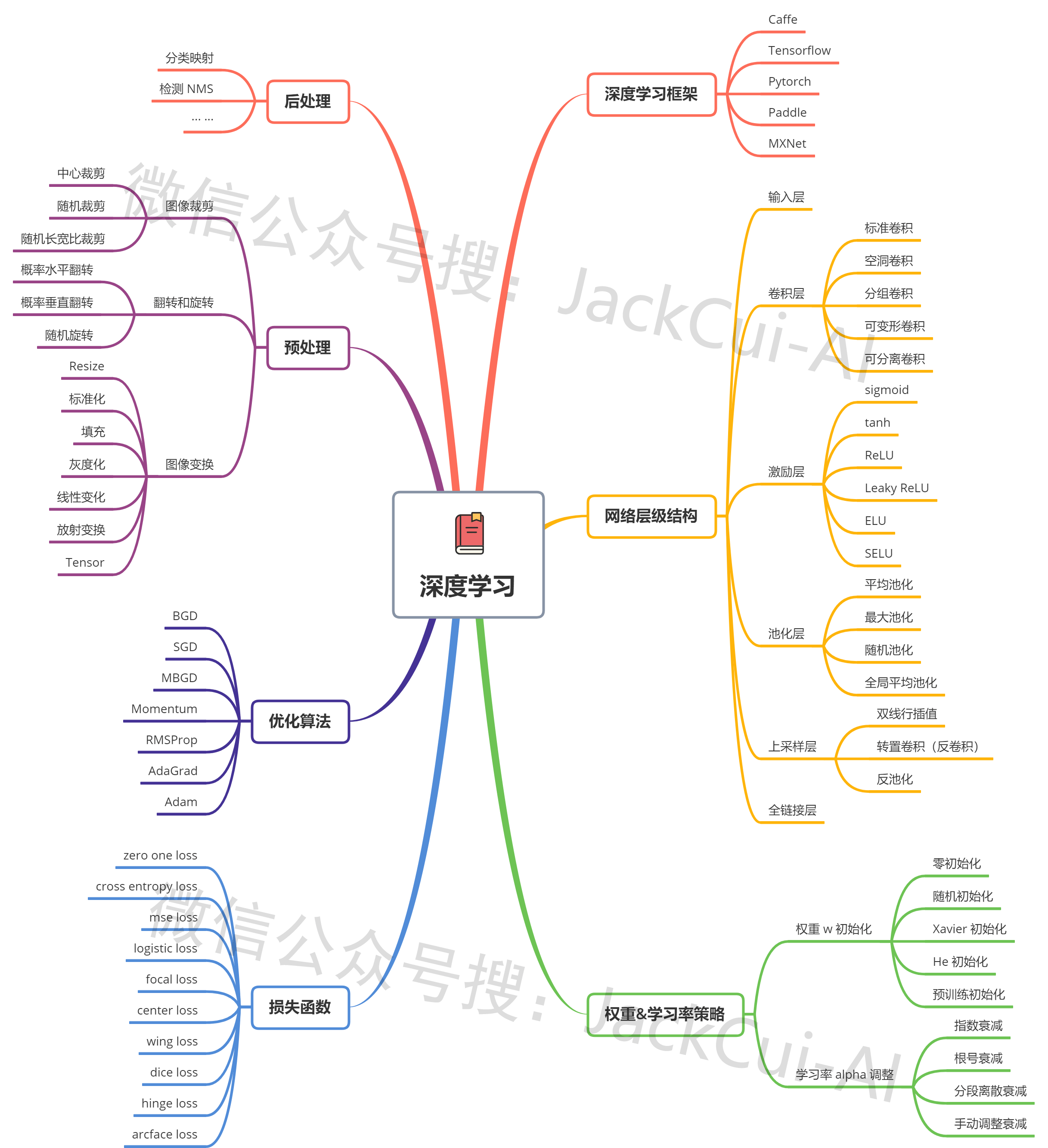
一、前言
承诺的图解 AI 算法系列教程,今天它来了!
最近,写了很多 AI 趣味性算法教程,目前写了 14 篇,其中反响不错的教程有:
- 你的红色高跟鞋,AI 换脸技术初体验
- 让图片动起来,特朗普和蒙娜丽莎深情合唱《Unravel》
- 为艺术而生的惊艳算法
- 百年老照片修复算法,那些高颜值的父母!
- 「完美复刻」的人物肖像画生成算法 U^2-Net
读者们玩得很开心,对 AI 算法、深度学习也来了兴趣。
但仅限于开心地跑包,这最多只能算是「调包侠」。
既然来了兴致,何不趁热打铁,多学些基础知识,争取早日迈入「调参侠」的行列。
大家一起炼丹,一起修炼。

图解 AI 算法系列教程,不仅仅是涉及深度学习基础知识,还会有强化学习、迁移学习等,再往小了讲就比如拆解目标检测算法,对抗神经网络(GAN)等等。
难度会逐渐增加,今天咱先热热身,来点轻松的,当作这个系列的开篇。
二、深度学习
想学深度学习,要掌握哪些基础知识?直接上图:
整理了小半天的思维导图,建议收藏!
深度学习主要由上图所示的几个部分组成,想学一个深度学习算法的原理,就看它是什么样的网络结构,Loss 是怎么计算的,预处理和后处理都是怎么做的。
权重初始化和学习率调整策略、优化算法、深度学习框架就那么多,并且也不是所有都要掌握,比如深度学习框架,Pytorch 玩的溜,就能应付大多数场景。
先有个整体的认知,然后再按照这个思维导图,逐个知识点学习,最后整合到一起,你会发现,你也可以自己实现各种功能的算法了。
深度学习的主要目的是从数据中自动学习到有效的特征表示,它是怎么工作的?那得从神经元说起。
随着神经科学、认知科学的发展,我们逐渐知道人类的智能行为都和大脑活动有关。
人脑神经系统[1]是一个非常复杂的组织,包含近 860 亿个神经元,这 860 亿的神经元构成了超级庞大的神经网络。
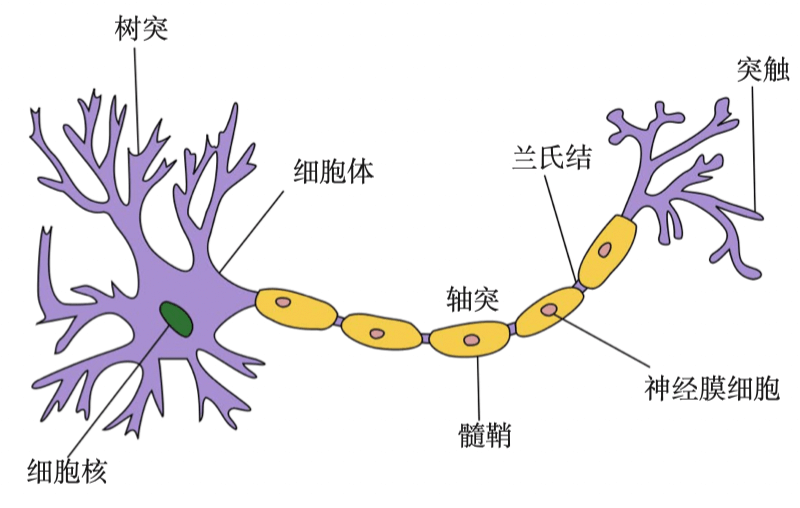
我们知道,一个人的智力不完全由遗传决定,大部分来自于生活经验。也就是说人脑神经网络是一个具有学习能力的系统。
不同神经元之间的突触有强有弱,其强度是可以通过学习(训练)来不断改变的,具有一定的可塑性,不同的连接又形成了不同的记忆印痕。
而深度学习的神经网络,就是受人脑神经网络启发,设计的一种计算模型,它从结构、实现机理和功能上模拟人脑神经网络。
比如下图就是一个最简单的前馈神经网络,第 0 层称为输入层,最后一层称为输出层,其他中间层称为隐藏层。
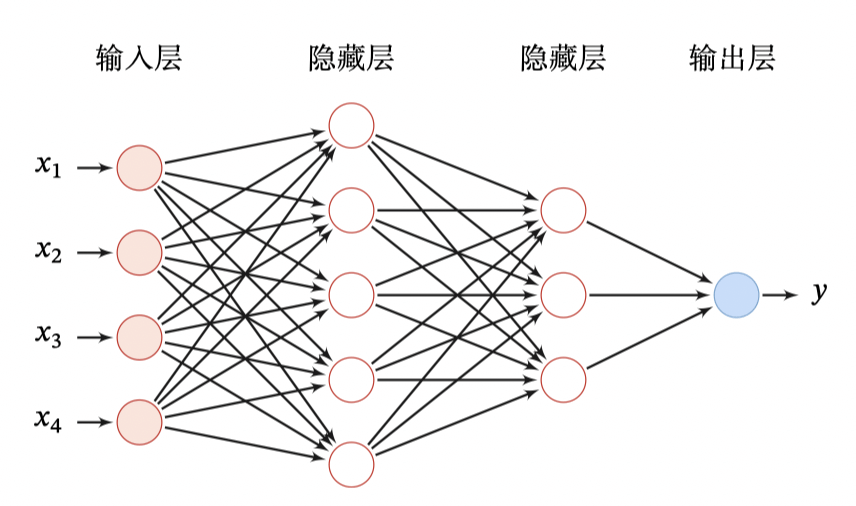
那神经网络如何工作的?网络层次结构、损失函数、优化算法、权重初始化、学习率调整都是如何运作的?
反向传播给你答案。前方,高能预警!
三、反向传播
要想弄懂深度学习原理,必须搞定反向传播[2]和链式求导法则。
先说思维导图里的网络层级结构,一个神经网络,可复杂可简单,为了方便推导,假设,你有这样一个网络层:
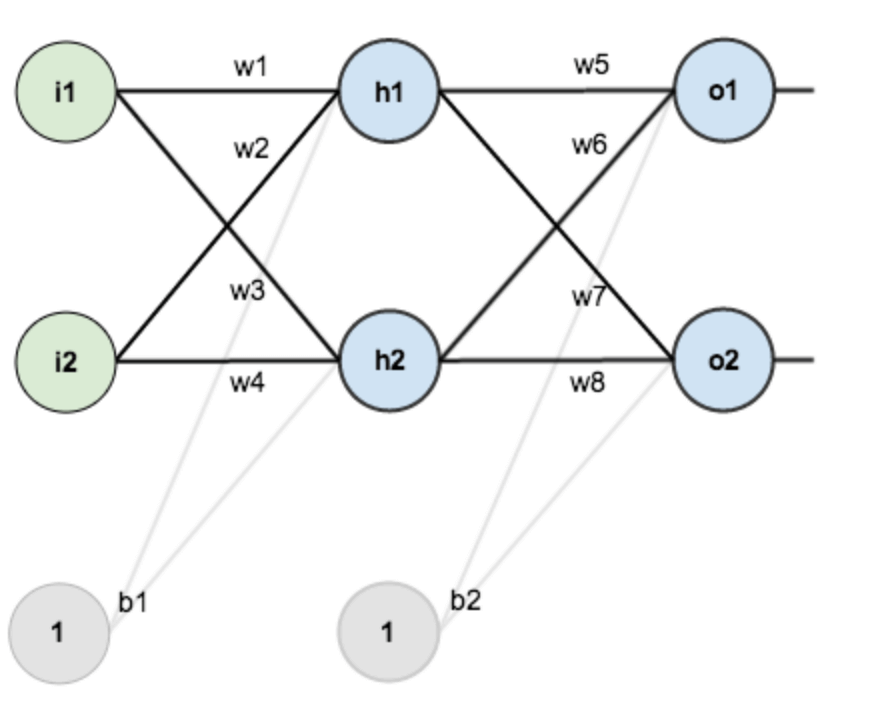
第一层是输入层,包含两个神经元 i1, i2 和截距项 b1(偏置);
第二层是隐含层,包含两个神经元 h1, h2 和截距项 b2 ;
第三层是输出层 o1 和 o2 ,每条线上标的 wi 是层与层之间连接的权重,激活函数我们默认为 sigmoid 函数。
在训练这个网络之前,需要初始化这些 wi 权重,这就是权重初始化,这里就有不少的初始化方法,我们选择最简单的,随机初始化。
随机初始化的结果,如下图所示:
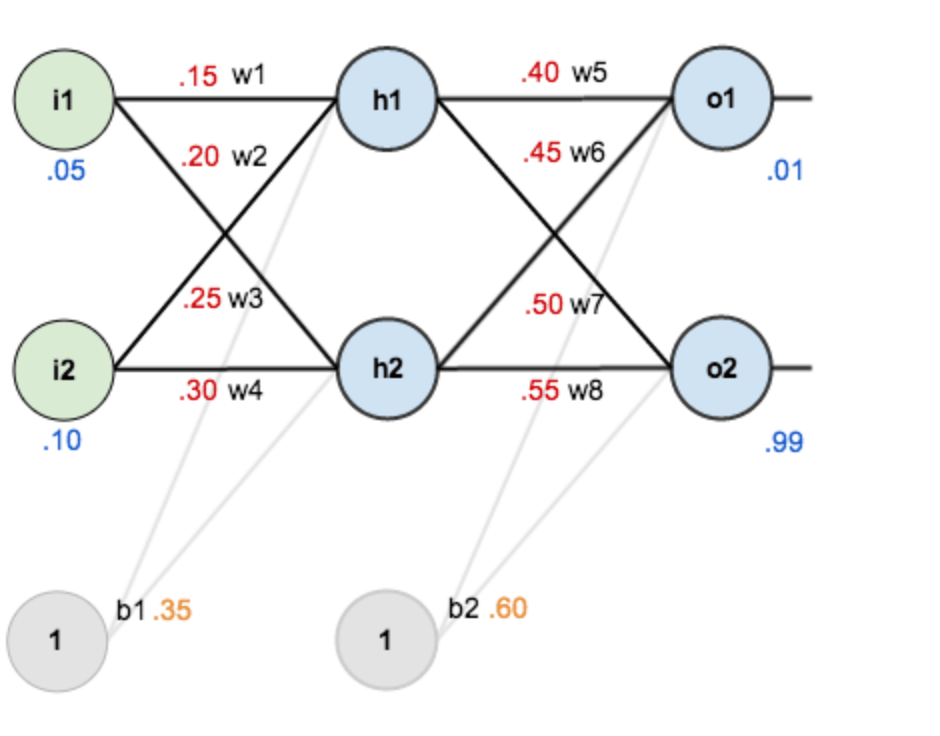
其中,输入数据: i1=0.05, i2=0.10;
输出数据(期望的输出) : o1=0.01, o2=0.99;
初始权重: w1=0.15, w2=0.20, w3=0.25, w4=0.30, w5=0.40, w6=0.45, w7=0.50, w8=0.55。
目标:给出输入数据 i1, i2(0.05 和 0.10),使输出尽可能与原始输出o1, o2(0.01 和 0.99)接近。
神经网络的工作流程分为两步:前向传播和反向传播。
1、前向传播
前向传播是将输入数据根据权重,计算到输出层。
1)输入层->隐藏层
计算神经元 h1 的输入加权和:
$$
\begin{array}{l}
\text { net }_{h 1}=w_{1} * i_{1}+w_{2} * i_{2}+b_{1} * 1 \\
\text { net }_{h 1}=0.15 * 0.05+0.2 * 0.1+0.35 * 1=0.3775
\end{array}
$$
神经元后面,要跟个激活层,从而引入非线性因素,这就像人的神经元一样,让细胞处于兴奋或抑制的状态。
数学模拟的形式就是通过激活函数,大于阈值就激活,反之抑制。
常用的激活函如思维导图所示,这里以非常简单的 sigmoid 激活函数为例,它的函数形式如下:
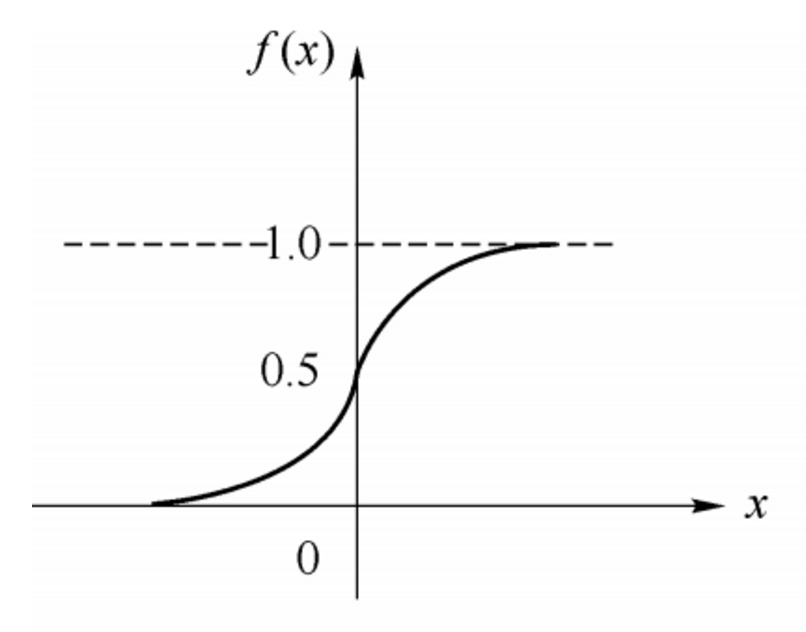
数学公式:
$$
f(x) = \frac{1}{1+e^{-x}}
$$
使用 sigmoid 激活函数,继续计算,神经元 h1 的输出 o_h1:
$$
\text { out }_{h 1}=\frac{1}{1+e^{-n e t_{h 1}}}=\frac{1}{1+e^{-0.3775}}=0.593269992
$$
同理,可计算出神经元 h2 的输出 o_h2:
$$
\text { out }_{h 2}=0.596884378
$$
2)隐藏层->输出层
计算输出层神经元 o1 和 o2 的值:
$$
\begin{array}{l}
\text { net }_{o 1}=w_{5} * \text { out }_{h 1}+w_{6} * \text { out }_{h 2}+b_{2} * 1 \\
\text { net }_{o 1}=0.4 * 0.593269992+0.45 * 0.596884378+0.6 * 1=1.105905967 \\
\text { out }_{o 1}=\frac{1}{1+e^{-n e t_{o 1}}}=\frac{1}{1+e^{-1.105905967}}=0.75136507
\end{array}
$$
这样前向传播的过程就结束了,根据输入值和权重,我们得到输出值为[0.75136079, 0.772928465],与实际值(目标)[0.01, 0.99]相差还很远,现在我们对误差进行反向传播,更新权值,重新计算输出。
2、反向传播
前向传播之后,发现输出结果与期望相差甚远,这时候就要更新权重了。
所谓深度学习的训练(炼丹),学的就是这些权重,我们期望的是调整这些权重,让输出结果符合我们的期望。
而更新权重的方式,依靠的就是反向传播。
1)计算总误差
一次前向传播过后,输出值(预测值)与目标值(标签值)有差距,那得衡量一下有多大差距。
衡量的方法,就是用思维导图中的损失函数。
损失函数也有很多,咱们还是选择一个最简单的,均方误差(MSE loss)。
均方误差的函数公式:
$$
M S E=\frac{1}{n} \sum_{i=1}^{n}\left(\hat{y}_{i}-y_{i}\right)^{2}
$$
根据公式,直接计算预测值与标签值的总误差:
$$
E_{\text {total}}=\sum \frac{1}{2}(\text {target}-\text {output})^{2}
$$
有两个输出,所以分别计算 o1 和 o2 的误差,总误差为两者之和:
$$
\begin{array}{l}
E_{o 1}=\frac{1}{2}\left(\text {target}_{o 1}-\text {out}_{o 1}\right)^{2}=\frac{1}{2}(0.01-0.75136507)^{2}=0.274811083 \\
E_{o 2}=0.023560026 \\
E_{\text {total}}=E_{o 1}+E_{o 2}=0.274811083+0.023560026=0.298371109
\end{array}
$$
2)隐含层->输出层的权值更新
以权重参数 w5 为例,如果我们想知道 w5 对整体误差产生了多少影响,可以用整体误差对 w5 求偏导求出。
这是链式法则,它是微积分中复合函数的求导法则,就是这个:
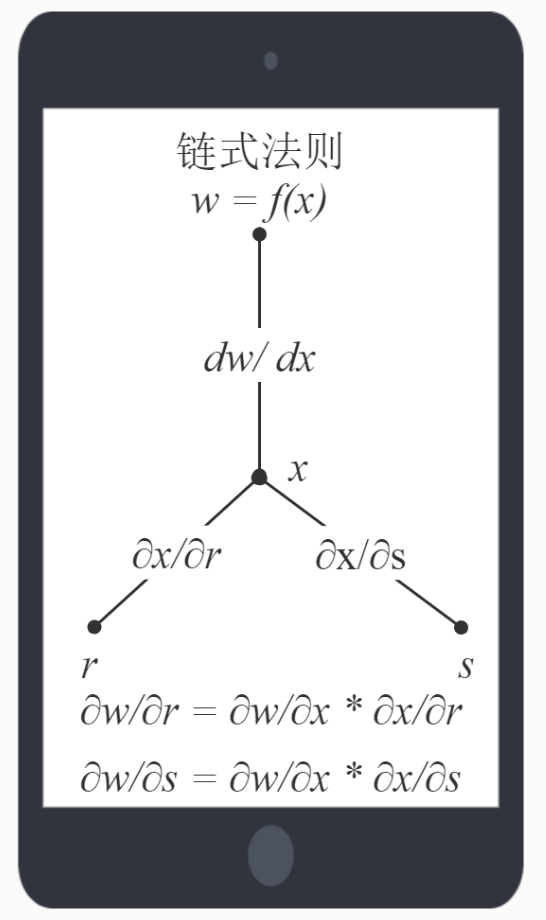
根据链式法则易得:
$$
\frac{\partial E_{\text {total}}}{\partial w_{5}}=\frac{\partial E_{\text {total}}}{\partial \text {out}_{o 1}} * \frac{\partial \text {out}_{o 1}}{\partial \text {net}_{o 1}} * \frac{\partial \text {net}_{o 1}}{\partial w_{5}}
$$
下面的图可以更直观的看清楚误差是怎样反向传播的:
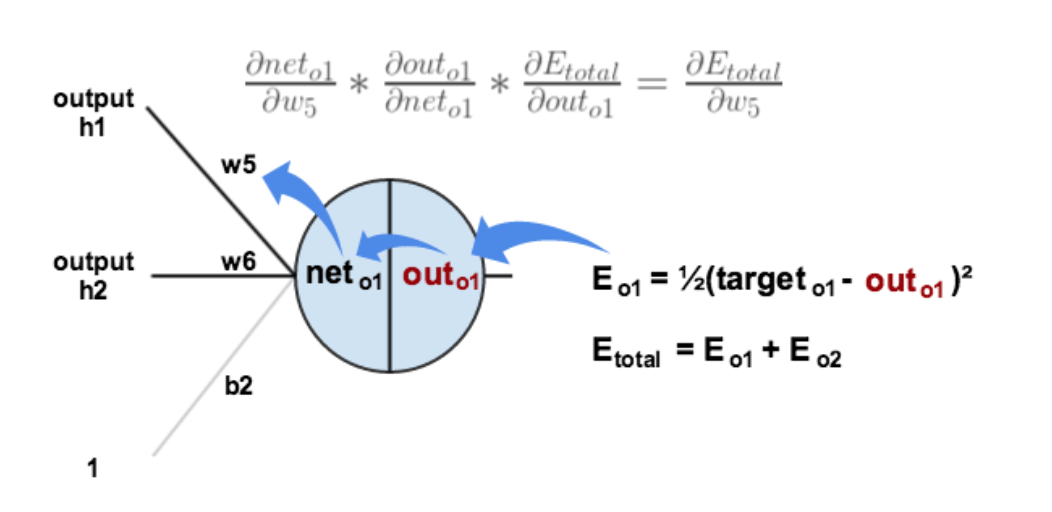
现在我们来分别计算每个式子的值:
计算\(\frac{\partial E_{\text {total}}}{\partial \text {out}_{o 1}}\):
$$
E_{\text {total}}=\frac{1}{2}\left(\text {target}_{o 1}-\text {out}_{o 1}\right)^{2}+\frac{1}{2}\left(\text {target}_{o 2}-\text {out}_{o 2}\right)^{2}
$$
$$
\frac{\partial E_{\text {tatal}}}{\partial o u t_{o 1}}=2 * \frac{1}{2}\left(\text {target}_{o 1}-\text {out}_{o 1}\right)^{2-1} *-1+0
$$
$$
\frac{\partial E_{\text {tatal }}}{\partial \text { out }_{\text {ol }}}=-\left(\text { target }_{\text {ol }}-\text { out }_{\text {ol }}\right)=-(0.01-0.75136507)=0.74136507
$$
计算\(\frac{\partial o u t_{o 1}}{\partial n e t_{o 1}}\):
$$
\begin{array}{l}
\text {out}_{o 1}=\frac{1}{1+e^{-n e t_{o 1}}} \\
\frac{\partial o u t_{o 1}}{\partial n e t_{o 1}}=o u t_{o 1}\left(1-o u t_{o 1}\right)=0.75136507(1-0.75136507)=0.186815602
\end{array}
$$
这一步实际上就是对sigmoid函数求导,比较简单,可以自己推导一下。
计算\(\frac{\partial n e t_{o 1}}{\partial w_{5}}\):
$$
\begin{array}{l}
\text { net }_{o 1}=w_{5} * \text { out }_{h 1}+w_{6} * \text { out }_{h 2}+b_{2} * 1 \\
\frac{\partial n e t_{o 1}}{\partial w_{5}}=1 * \text { out }_{h 1} * w_{5}^{(1-1)}+0+0=\text { out }_{h 1}=0.593269992
\end{array}
$$
最后三者相乘:
$$
\frac{\partial E_{\text {total}}}{\partial w_{5}}=\frac{\partial E_{\text {total}}}{\partial o u t_{o 1}} * \frac{\partial \text {out}_{o 1}}{\partial n e t_{o 1}} * \frac{\partial n e t_{o 1}}{\partial w_{5}}
$$
$$
\frac{\partial E_{t t a l}}{\partial w_{5}}=0.74136507 * 0.186815602 * 0.593269992=0.082167041
$$
这样我们就计算出整体误差E(total)对 w5 的偏导值。
回过头来再看看上面的公式,我们发现:
$$
\frac{\partial E_{\text {tatal }}}{\partial u_{5}}=-\left(\text {target}_{o 1}-\text { out }_{\text {ol }}\right) * \text { out }_{\text {ol }}\left(1-\text { out }_{\text {ol }}\right) * \text { out }_{h 1}
$$
为了表达方便,用\(\delta_{o 1}\)来表示输出层的误差:
$$
\delta_{o 1}=\frac{\partial E_{\text {total }}}{\text { dout }_{\text {ol }}} * \frac{\text { dout }_{\text {ol }}}{\text { Onet }_{\text {ol }}}=\frac{\partial E_{\text {total }}}{\text { onet }_{\text {ol }}}
$$
$$
\delta_{o 1}=-\left(\text {target}_{o 1}-o u t_{o 1}\right) * \text { out }_{o 1}\left(1-\text { out }_{o 1}\right)
$$
因此,整体误差E(total)对w5的偏导公式可以写成:
$$
\frac{\partial E_{\text {total}}}{\partial w_{5}}=\delta_{o 1} \text { out }_{h 1}
$$
如果输出层误差计为负的话,也可以写成:
$$
\frac{\partial E_{t o t a l}}{\partial w_{5}}=-\delta_{o 1} \text { out }_{h 1}
$$
最后我们来更新 w5 的值:
$$
w_{5}^{+}=w_{5}-\eta * \frac{\partial E_{t o t a l}}{\partial w_{5}}=0.4-0.5 * 0.082167041=0.35891648
$$
这个更新权重的策略,就是思维导图中的优化算法,
η
是学习率,我们这里取0.5。
如果学习率要根据迭代的次数调整,那就用到了思维导图中的学习率调整。
同理,可更新w6,w7,w8:
$$
\begin{array}{l}
w_{6}^{+}=0.408666186 \\
w_{7}^{+}=0.511301270 \\
w_{8}^{+}=0.561370121
\end{array}
$$
3)隐含层->隐含层的权值更新
方法其实与上面说的差不多,但是有个地方需要变一下,在上文计算总误差对 w5 的偏导时,是从out(o1)->net(o1)->w5,但是在隐含层之间的权值更新时,是out(h1)->net(h1)->w1,而 out(h1) 会接受 E(o1) 和 E(o2) 两个地方传来的误差,所以这个地方两个都要计算。
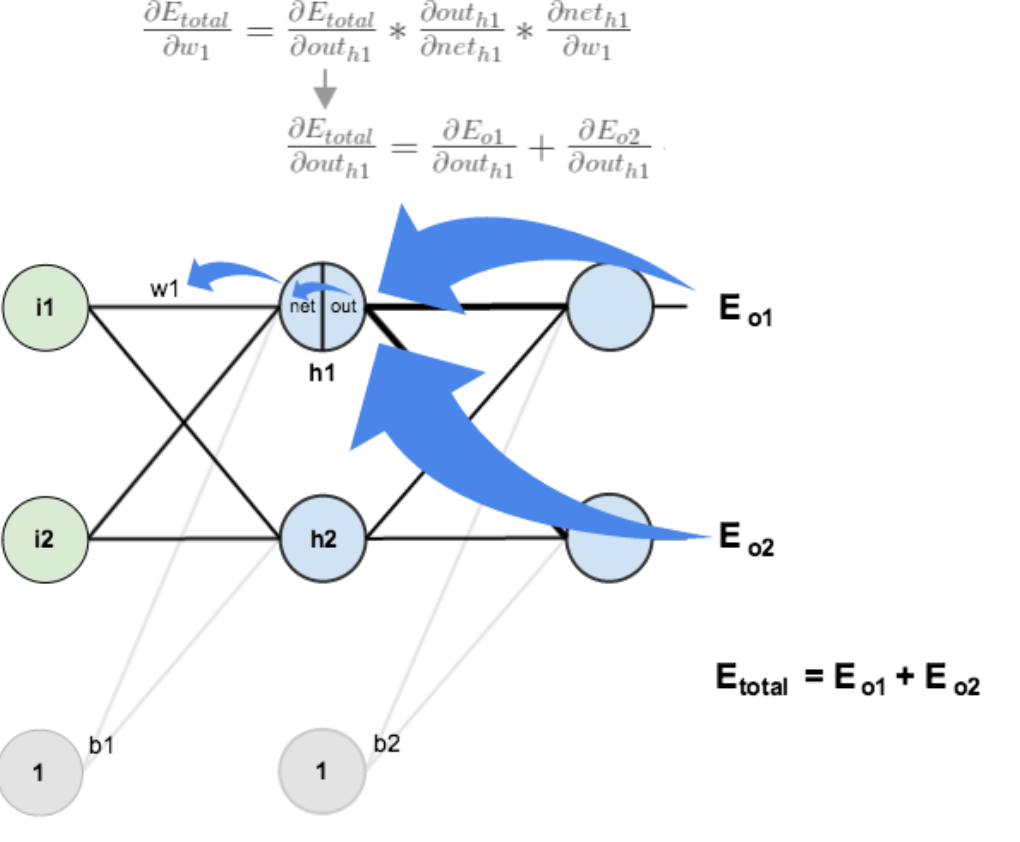
计算\(\frac{\partial E_{\text {total}}}{\partial \text {out}_{h 1}}\):
$$
\frac{\partial E_{\text {total}}}{\partial o u t_{h 1}}=\frac{\partial E_{o 1}}{\partial o u t_{h 1}}+\frac{\partial E_{o 2}}{\partial o u t_{h 1}}
$$
先计算\(\frac{\partial E_{o 1}}{\partial o u t_{h 1}}\):
$$
\begin{array}{l}
\frac{\partial E_{o 1}}{\partial o u t_{h 1}}=\frac{\partial E_{o 1}}{\partial n e t_{o 1}} * \frac{\partial n e t_{o 1}}{\partial o u t_{h 1}} \\
\frac{\partial E_{o 1}}{\partial n e t_{o 1}}=\frac{\partial E_{o 1}}{\partial o u t_{o 1}} * \frac{\partial o u t_{o 1}}{\partial n e t_{o 1}}=0.74136507 * 0.186815602=0.138498562 \\
\text { net }_{o 1}=w_{5} * \text { out }_{h 1}+w_{6} * \text { out }_{h 2}+b_{2} * 1 \\
\frac{\partial n e t_{o 1}}{\partial o u t_{h 1}}=w_{5}=0.40 \\
\frac{\partial E_{o 1}}{\partial o u t_{h 1}}=\frac{\partial E_{o 1}}{\partial n e t_{o 1}} * \frac{\partial n e t_{o 1}}{\partial o u t_{h 1}}=0.138498562 * 0.40=0.055399425
\end{array}
$$
同理,计算出:
$$
\frac{\partial E_{o 2}}{\partial o u t_{h 1}}=-0.019049119
$$
两者相加得到总值:
$$
\frac{\partial E_{\text {total}}}{\partial o u t_{h 1}}=\frac{\partial E_{o 1}}{\partial o u t_{h 1}}+\frac{\partial E_{o 2}}{\partial o u t_{h 1}}=0.055399425+-0.019049119=0.036350306
$$
再计算\(\frac{\partial o u t_{h 1}}{\partial n e t_{h 1}}\):
$$
\begin{array}{l}
\text { out }_{h 1}=\frac{1}{1+e^{-n e t} t_{h 1}} \\
\frac{\text { out }_{h 1}}{\partial \text { net }_{h 1}}=\text { out }_{h 1}\left(1-\text { out }_{h 1}\right)=0.59326999(1-0.59326999)=0.241300709
\end{array}
$$
再计算\(\frac{\partial n e t_{h 1}}{\partial w_{1}}\):
$$
\begin{array}{l}
\text {net}_{h 1}=w_{1} * i_{1}+w_{2} * i_{2}+b_{1} * 1 \\
\frac{\partial \text {net}_{h 1}}{\partial w_{1}}=i_{1}=0.05
\end{array}
$$
最后,三者相乘:
$$
\begin{array}{l}
\frac{\partial E_{t o t a l}}{\partial w_{1}}=\frac{\partial E_{t o t a l}}{\partial o u t_{h 1}} * \frac{\partial o u t_{h} 1}{\partial n e t_{h 1}} * \frac{\partial n e t_{h 1}}{\partial w_{1}} \\
\frac{\partial E_{t o t a l}}{\partial w_{1}}=0.036350306 * 0.241300709 * 0.05=0.000438568
\end{array}
$$
为了简化公式,用 sigma(h1) 表示隐含层单元 h1 的误差:
$$
\begin{aligned}
\frac{\partial E_{t o t a l}}{\partial w_{1}} &=\left(\sum_{o} \frac{\partial E_{t o t a l}}{\partial o u t_{o}} * \frac{\partial o u t_{o}}{\partial n e t_{o}} * \frac{\partial n e t_{o}}{\partial o u t_{h 1}}\right) * \frac{\partial o u t_{h} 1}{\partial n e t_{h 1}} * \frac{\partial n e t_{h 1}}{\partial w_{1}} \\
\frac{\partial E_{t o t a l}}{\partial w_{1}} &=\left(\sum_{o} \delta_{o} * w_{h o}\right) * \text {out}_{h 1}\left(1-o u t_{h 1}\right) * i_{1} \\
\frac{\partial E_{t o t a l}}{\partial w_{1}} &=\delta_{h 1} i_{1}
\end{aligned}
$$
最后,更新 w1 的权值:
$$
w_{1}^{+}=w_{1}-\eta * \frac{\partial E_{t o t a l}}{\partial w_{1}}=0.15-0.5 * 0.000438568=0.149780716
$$
同理,额可更新w2,w3,w4的权值:
$$
\begin{array}{l}
w_{2}^{+}=0.19956143 \\
w_{3}^{+}=0.24975114 \\
w_{4}^{+}=0.29950229
\end{array}
$$
这样误差反向传播法就完成了,最后我们再把更新的权值重新计算,不停地迭代。
在这个例子中第一次迭代之后,总误差E(total)由0.298371109下降至0.291027924。
迭代10000次后,总误差为0.000035085,输出为[0.015912196,0.984065734](原输入为[0.01,0.99]),证明效果还是不错的。
这就是整个神经网络的工作原理,如果你跟着思路,顺利看到这里。那么恭喜你,深度学习的学习算是通过了一关。
四、Python 实现
整个过程,可以用 Python 代码实现。
#coding:utf-8
import random
import math
#
# 参数解释:
# "pd_" :偏导的前缀
# "d_" :导数的前缀
# "w_ho" :隐含层到输出层的权重系数索引
# "w_ih" :输入层到隐含层的权重系数的索引
class NeuralNetwork:
LEARNING_RATE = 0.5
def __init__(self, num_inputs, num_hidden, num_outputs, hidden_layer_weights = None, hidden_layer_bias = None, output_layer_weights = None, output_layer_bias = None):
self.num_inputs = num_inputs
self.hidden_layer = NeuronLayer(num_hidden, hidden_layer_bias)
self.output_layer = NeuronLayer(num_outputs, output_layer_bias)
self.init_weights_from_inputs_to_hidden_layer_neurons(hidden_layer_weights)
self.init_weights_from_hidden_layer_neurons_to_output_layer_neurons(output_layer_weights)
def init_weights_from_inputs_to_hidden_layer_neurons(self, hidden_layer_weights):
weight_num = 0
for h in range(len(self.hidden_layer.neurons)):
for i in range(self.num_inputs):
if not hidden_layer_weights:
self.hidden_layer.neurons[h].weights.append(random.random())
else:
self.hidden_layer.neurons[h].weights.append(hidden_layer_weights[weight_num])
weight_num += 1
def init_weights_from_hidden_layer_neurons_to_output_layer_neurons(self, output_layer_weights):
weight_num = 0
for o in range(len(self.output_layer.neurons)):
for h in range(len(self.hidden_layer.neurons)):
if not output_layer_weights:
self.output_layer.neurons[o].weights.append(random.random())
else:
self.output_layer.neurons[o].weights.append(output_layer_weights[weight_num])
weight_num += 1
def inspect(self):
print('------')
print('* Inputs: {}'.format(self.num_inputs))
print('------')
print('Hidden Layer')
self.hidden_layer.inspect()
print('------')
print('* Output Layer')
self.output_layer.inspect()
print('------')
def feed_forward(self, inputs):
hidden_layer_outputs = self.hidden_layer.feed_forward(inputs)
return self.output_layer.feed_forward(hidden_layer_outputs)
def train(self, training_inputs, training_outputs):
self.feed_forward(training_inputs)
# 1. 输出神经元的值
pd_errors_wrt_output_neuron_total_net_input = [0] * len(self.output_layer.neurons)
for o in range(len(self.output_layer.neurons)):
# ∂E/∂zⱼ
pd_errors_wrt_output_neuron_total_net_input[o] = self.output_layer.neurons[o].calculate_pd_error_wrt_total_net_input(training_outputs[o])
# 2. 隐含层神经元的值
pd_errors_wrt_hidden_neuron_total_net_input = [0] * len(self.hidden_layer.neurons)
for h in range(len(self.hidden_layer.neurons)):
# dE/dyⱼ = Σ ∂E/∂zⱼ * ∂z/∂yⱼ = Σ ∂E/∂zⱼ * wᵢⱼ
d_error_wrt_hidden_neuron_output = 0
for o in range(len(self.output_layer.neurons)):
d_error_wrt_hidden_neuron_output += pd_errors_wrt_output_neuron_total_net_input[o] * self.output_layer.neurons[o].weights[h]
# ∂E/∂zⱼ = dE/dyⱼ * ∂zⱼ/∂
pd_errors_wrt_hidden_neuron_total_net_input[h] = d_error_wrt_hidden_neuron_output * self.hidden_layer.neurons[h].calculate_pd_total_net_input_wrt_input()
# 3. 更新输出层权重系数
for o in range(len(self.output_layer.neurons)):
for w_ho in range(len(self.output_layer.neurons[o].weights)):
# ∂Eⱼ/∂wᵢⱼ = ∂E/∂zⱼ * ∂zⱼ/∂wᵢⱼ
pd_error_wrt_weight = pd_errors_wrt_output_neuron_total_net_input[o] * self.output_layer.neurons[o].calculate_pd_total_net_input_wrt_weight(w_ho)
# Δw = α * ∂Eⱼ/∂wᵢ
self.output_layer.neurons[o].weights[w_ho] -= self.LEARNING_RATE * pd_error_wrt_weight
# 4. 更新隐含层的权重系数
for h in range(len(self.hidden_layer.neurons)):
for w_ih in range(len(self.hidden_layer.neurons[h].weights)):
# ∂Eⱼ/∂wᵢ = ∂E/∂zⱼ * ∂zⱼ/∂wᵢ
pd_error_wrt_weight = pd_errors_wrt_hidden_neuron_total_net_input[h] * self.hidden_layer.neurons[h].calculate_pd_total_net_input_wrt_weight(w_ih)
# Δw = α * ∂Eⱼ/∂wᵢ
self.hidden_layer.neurons[h].weights[w_ih] -= self.LEARNING_RATE * pd_error_wrt_weight
def calculate_total_error(self, training_sets):
total_error = 0
for t in range(len(training_sets)):
training_inputs, training_outputs = training_sets[t]
self.feed_forward(training_inputs)
for o in range(len(training_outputs)):
total_error += self.output_layer.neurons[o].calculate_error(training_outputs[o])
return total_error
class NeuronLayer:
def __init__(self, num_neurons, bias):
# 同一层的神经元共享一个截距项b
self.bias = bias if bias else random.random()
self.neurons = []
for i in range(num_neurons):
self.neurons.append(Neuron(self.bias))
def inspect(self):
print('Neurons:', len(self.neurons))
for n in range(len(self.neurons)):
print(' Neuron', n)
for w in range(len(self.neurons[n].weights)):
print(' Weight:', self.neurons[n].weights[w])
print(' Bias:', self.bias)
def feed_forward(self, inputs):
outputs = []
for neuron in self.neurons:
outputs.append(neuron.calculate_output(inputs))
return outputs
def get_outputs(self):
outputs = []
for neuron in self.neurons:
outputs.append(neuron.output)
return outputs
class Neuron:
def __init__(self, bias):
self.bias = bias
self.weights = []
def calculate_output(self, inputs):
self.inputs = inputs
self.output = self.squash(self.calculate_total_net_input())
return self.output
def calculate_total_net_input(self):
total = 0
for i in range(len(self.inputs)):
total += self.inputs[i] * self.weights[i]
return total + self.bias
# 激活函数sigmoid
def squash(self, total_net_input):
return 1 / (1 + math.exp(-total_net_input))
def calculate_pd_error_wrt_total_net_input(self, target_output):
return self.calculate_pd_error_wrt_output(target_output) * self.calculate_pd_total_net_input_wrt_input();
# 每一个神经元的误差是由平方差公式计算的
def calculate_error(self, target_output):
return 0.5 * (target_output - self.output) ** 2
def calculate_pd_error_wrt_output(self, target_output):
return -(target_output - self.output)
def calculate_pd_total_net_input_wrt_input(self):
return self.output * (1 - self.output)
def calculate_pd_total_net_input_wrt_weight(self, index):
return self.inputs[index]
# 文中的例子:
nn = NeuralNetwork(2, 2, 2, hidden_layer_weights=[0.15, 0.2, 0.25, 0.3], hidden_layer_bias=0.35, output_layer_weights=[0.4, 0.45, 0.5, 0.55], output_layer_bias=0.6)
for i in range(10000):
nn.train([0.05, 0.1], [0.01, 0.09])
print(i, round(nn.calculate_total_error([[[0.05, 0.1], [0.01, 0.09]]]), 9))
#另外一个例子,可以把上面的例子注释掉再运行一下:
# training_sets = [
# [[0, 0], [0]],
# [[0, 1], [1]],
# [[1, 0], [1]],
# [[1, 1], [0]]
# ]
# nn = NeuralNetwork(len(training_sets[0][0]), 5, len(training_sets[0][1]))
# for i in range(10000):
# training_inputs, training_outputs = random.choice(training_sets)
# nn.train(training_inputs, training_outputs)
# print(i, nn.calculate_total_error(training_sets))
五、其他
预处理和后处理就相对简单很多,预处理就是一些常规的图像变换操作,数据增强方法等。
后处理每个任务都略有不同,比如目标检测的非极大值抑制等,这些内容可以放在以后再讲。
至于深度学习框架的学习,那就是另外一大块内容了,深度学习框架是一种为了深度学习开发而生的工具,库和预训练模型等资源的总和。
我们可以用 Python 实现简单的神经网络,但是复杂的神经网络,还得靠框架,框架的使用可以大幅度降低我们的开发成本。
至于学哪种框架,看个人喜好,Pytorch 和 Tensorflow 都行。人生苦短,我选 Pytorch。
六、学习资料推荐
学完本文,只能算是深度学习入门,还有非常多的内容需要深入学习。
推荐一些资料,方便感兴趣的读者继续研究。
视频:
-
吴恩达的深度学习公开课[3]:https://mooc.study.163.com/university/deeplearning_ai
书籍:
-
《神经网络与深度学习》 -
《PyTorch深度学习实战》
开源项目:
-
Pytorch教程 1:https://github.com/yunjey/pytorch-tutorial -
Pytorch教程 2:https://github.com/pytorch/tutorials
视频和书籍,公众号后台回复「666」有惊喜哦!
七、絮叨
学习的积累是个漫长而又孤独的过程,厚积才能薄发,有不懂的知识就多看多想,要相信最后胜利的,是坚持下去的那个人。
本文硬核,如果喜欢,还望转发、再看多多支持。
我是 Jack,我们下期见。
参考资料:
推荐深度学习书籍: 《神经网络与深度学习》
反向传播: https://www.cnblogs.com/charlotte77/p/5629865.html
吴恩达的深度学习公开课: https://mooc.study.163.com/university/deeplearning_ai
文章持续更新,可以微信公众号搜索【JackCui-AI】第一时间阅读,本文 GitHub https://github.com/Jack-Cherish/PythonPark 已经收录,有大厂面试完整考点,欢迎Star。
来源:
https://cuijiahua.com/blog/2020/11/dl-basics-2.html
